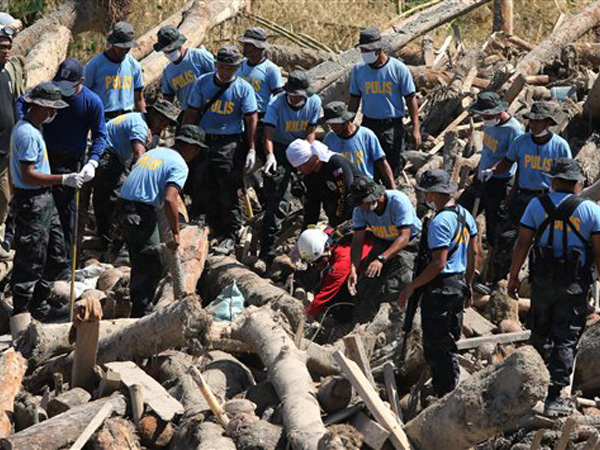
This handout photo released by the Philippine National Police shows police search around toppled tree trunks caused by powerful typhoon Pablo (Bopha) in New Bataan, Compostela Valley, on Monday, Dec. 10, 2012. Two high-ranking environment officials in Southern Mindanao downplayed suspicions that illegal logging and mining activities exacerbated the impact of the typhoon in the hardest-hit provinces of Compostela Valley province and Davao Oriental. AP/PHILIPPINE NATIONAL POLICE PIO, LEONITO NAVALES
DAVAO CITY, Philippines—Two high-ranking environment officials in Southern Mindanao downplayed suspicions that illegal logging and mining activities exacerbated the impact of typhoon “Pablo” in the hardest-hit provinces of Compostela Valley province and Davao Oriental.
Joselyn Marcus Fragada, director of the Department of Environment and Natural Resources in Southern Mindanao, told reporters here that “typhoons now are not as weak as they were” and that is because of climate change.
He said illegal logging and illegal mining activities—which the DENR has been combating—were only circumstantial and that “nature is the worst enemy.”
Edilberto Arreza, chief of the Mines and Sciences Bureau in Southern Mindanao, said mining activities did not worsen Pablo’s effect in the two provinces.
He cited a report by the Office of the Civil Defense that said most of the deaths were caused by rampaging waters, not landslide.
Compostela Valley Gov. Arturo Uy earlier said that there were no mining activities in Barangay (village) Andap in New Bataan, Compostela Valley, the area where the high number of deaths was recorded.
He said Andap hosts the town’s watershed and is a protected area.
“There are also resorts in that area so how come there’s mining or logging there?” Uy asked, adding that resort owners would have been the first ones to raise a howl if mining was allowed in the village.
Davao del Norte Gov. Rodolfo del Rosario said environment officials should not automatically dismiss suspicions that illegal logging and mining have contributed to the devastating effect of the typhoon.
“It is something that should be looked into,” he said, adding that Compostela Valley and some parts of Davao del Norte play host to mining activities.
But Del Rosario also agreed that it could be in Compostela Valley where Pablo’s “eye” was, which would explain why the devastation there was so extensive. “It seems that typhoon Pablo really targeted Compostela Valley,” he said.

